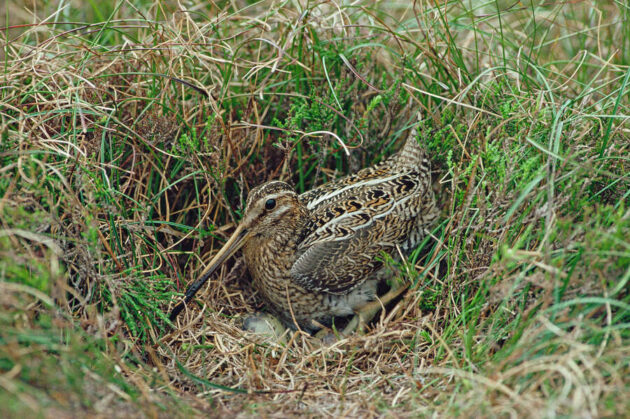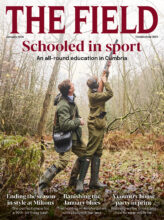With its cryptic plumage, striking beak and curious drumming behaviour, the snipe is a fascinating bird that has captivated sportsmen for generations
Bel Chapman’s summing up of the snipe is hard to better: ‘The most shifty and capricious of all gamebirds – here today, gone tomorrow,’ he noted in his book Bird-Life of the Borders. He added how these birds will often sit tight until almost trodden on, while on other occasions ‘they spring at a couple of gun-shots’ distance’. He found it difficult to account for ‘all their vagaries’ but concluded that, apart from the weather, the main factor influencing their movements is the moon. On moonlit nights they will ‘feed abundantly all night’ but ‘in wild weather when the moon is overcast they are compelled to feed partially by day, and at such times are more watchful and wild’.

Snipe usually occur in small groups, or wisps
Skilled observer
Chapman, who was born in 1851, was not only a noted sportsman, pioneer conservationist and talented artist but also a skilled observer of wildlife, as these thoughts on snipe remind us. The snipe, like its cousin the woodcock, is clearly a bird whose habits are inextricably linked to the cycles of the moon but that’s something that few modern bird books mention. Today we may know a great deal more about the snipe’s ecology than did Chapman but of the bird itself we probably know less.
I’ve been fascinated by snipe all my life. I encountered my first on a sewage farm when I was 13. The farm, in south Croydon, was a long cycle ride from home. Here my friend Martin and I were (rather surprisingly) given permission to walk between the settling beds, looking for birds, and I still remember the excitement of flushing my first snipe and watching it rocket away, uttering its distinctive cry that is best described as like tearing paper. We put up several more before we at last spied one on the ground, enabling us to admire its beautifully cryptic plumage and marvel at a beak that looks as long as the bird itself.
That sewage farm was converted to a country park many years ago; today your chances of finding a snipe there are nil. Predictably, loss of habitat is the main reason for the snipe’s decline in England, where, according to Bird Atlas 2007-11, numbers fell by 13% between 1995-2010, though conversely the same period saw a 30% increase in Scotland.
The past 50 years have seen their disappearance as breeding birds from much of southern and eastern England. In my home county of Suffolk these birds were regarded by Ticehurst, writing in his History of the Birds of Suffolk (1932), as common breeding birds, nesting ‘plentifully throughout the county where there are marshes of the requisite amount of wetness and roughness’. Consulting Suffolk Birds 2023 reveals the last proven nesting was in 2007.
Most studies have attributed the snipe’s decline to agricultural intensification and the drainage of wet, tussocky grassland. Today the snipe’s breeding strongholds are in Scotland, north-west England and in the midlands and west of Ireland. We do know that our native snipe are partially migratory. Ticehurst found that they were abundant in Suffolk until the last week of July but by ‘1st August when the shooting season opens, hardly one is to be seen’. He added that September was usually a blank month for the snipe-shooter, for the winter migrants didn’t start to arrive until mid-October.
It’s impossible to make more than an educated guess as to how many snipe winter in the British Isles but it is generally reckoned that as many as a million birds come here, dwarfing our local winter population of around 70,000. Ringing recoveries indicate that most of the migrants to mainland Britain are from the Baltic states, Germany, central Europe and Russia. Birds from Iceland winter predominately in Ireland. Ringing recoveries have shown that snipe breeding in northern Britain also move to Ireland for the winter. Britain is also considered to be an important stopover for snipe heading for wintering grounds farther south in Europe.
Studies have revealed that individual birds will return to the same wintering grounds in successive years, while prime habitats can attract considerable gatherings of birds. Unlike most waders, they are not really gregarious but they usually occur in small groups, or wisps. My observations suggest that they like to feed in the loose company of other snipe, perhaps because this provides greater security from predators. When feeding they usually remain a metre or so apart from each other; any closer and they start to display aggression.

The snipe’s beak, which is between six and seven centimetres long, is its most striking feature
Striking beak
Physically, the most striking thing about a snipe is its beak, which is between six and seven centimetres long. What is remarkable about it, other than its length, is its flexibility: the upper mandible can be bent upwards at what looks like a dangerous angle. The beak is also exceptionally sensitive, for food is located by touch, with the beak typically probed to its full length. Menteith Ogilvie, writing in 1920, describes beautifully the quick probing of a feeding snipe that occasionally ‘would thrust his bill well into the mud, and hold it motionless for a second or two – then push it in a little farther with a powerful kick of his feet, as though there was something just out of his reach’. Snipe feed on a rich variety of invertebrates, from spiders to earthworms, but have also been recorded taking tadpoles and small frogs, leeches and beetles and even seeds.
I was 14 when I heard my first drumming snipe, on an April day on Cley Marshes in North Norfolk. At first I didn’t know where the strange, almost ethereal sound was coming from or even what was making it but eventually I spotted the displaying bird, high above the reedbed. I watched as it rose in the sky before diving at an angle of 45 degrees with spread wings and tail. I could see, too, that the two outer tail feathers were widely extended. It is these feathers that vibrate and make the so-called drumming noise, often described as sounding like a bleating goat. Victorian naturalists debated how it was made. Some thought it vocal, while others claimed that it was the wind rushing through the bird’s wings. It wasn’t until 1952 that it was concluded that the sound was produced primarily by air vibrating the stiff outer tail feathers as the bird makes a power dive.

Snipe locate food by touch, with the beak typically probed to its full length
Drumming is a territorial display made by the male, and it can be seen and heard from March to July and occasionally in other months too. Though birds will drum at any time of day, dawn and dusk on still days are favoured. Once, on Islay in late July, I flushed a snipe with small chicks. Much to my surprise, the old bird flew up and started drumming – apparently both sexes may perform a drumming flight as a form of aerial demonstration.
Snipe are early nesters, with the males arriving on the breeding grounds around two weeks before the females. The females, when they first show up, are promiscuous, mating with several males in succession but eventually settling into one territory, forming a pair bond with the resident male. The clutch is of four, rarely five, eggs; when the young hatch the parents divide the brood between them and immediately lose contact with each other. The young grow quickly and within about 21 days they are fully fledged and independent from their parent, which they closely resemble as the juvenile plumage is similar to the adult’s.

As a ground-nesting species, snipe are highly vulnerable to predation
Like all ground-nesting birds, snipe are vulnerable to predators such as stoats and mink, while hedgehogs will also take their eggs. On their breeding grounds they are a favourite prey of merlins, hen harriers and peregrines. They have, of course, long been a popular gamebird. The diaries of the redoubtable Colonel Peter Hawker record that he shot no fewer than 2,116 during his long career from 1802 to 1853. To put this figure into perspective, his lifetime bag of wigeon was 2,211 and grey partridges 7,035: the only two species that he shot more of. It’s worth remembering that the word ‘sniper’ originates from British India in the late 18th century, when celebrated sportsmen who were a crack shot on snipe were known as ‘snipers’.
Today the snipe has the longest open season of any gamebird, from 12 August to 31 January. This is prompting calls from some quarters for the season to be shortened or the bird to be protected entirely. However, according to the British Trust for Ornithology (BTO) Migration Atlas (2002) ‘it is almost certainly not hunting pressure that has caused the decline in population in Britain and Ireland in the last 20 years, since hunting pressure on snipe has, if anything, been in decline in Europe since the 1950s’. Land drainage and the loss of wetlands remains the greatest threat to the snipe’s future. Intriguingly, a study by the BTO has predicted that the snipe (along with the avocet and common tern) is a bird that is likely to increase in numbers due to climate change. It’s not all bad news. (Read: Endangered waders – how grouse moors can help them.)
The different types of snipe

Jack snipe
Jack snipe
Though the common snipe (Gallinago gallinago) is the bird you are most likely to encounter in Britain, where it’s the most widespread wintering wader, three other species occur
Around 100,000 jack snipe (Lymnocryptes minimus) are thought to winter here but the accuracy of this figure is debatable, as these diminutive snipe are difficult to see, let alone count. David Bannerman in The Birds of the British Isles aptly describes the jack as ‘a small, rather dark wader which rise with disconcerting suddenness at the sportsman’s feet, to pitch as abruptly, perhaps no more than a gunshot farther on’. Noticeably shorter beaked than a common snipe, a jack is a tiny bird, weighing around 50g. It is protected in Britain but can still be shot legally, in season, in Northern Ireland.

Great snipe
Great snipe
One’s chances of encountering a great snipe (Gallinago media) in Britain are poor – it’s a vagrant here. Sometimes known as a double snipe, this is a bigger bird than its abundant cousin, with a shorter, stouter beak and legs, and barred flanks. Though I’ve never seen one in the UK, I’ve watched them on their breeding grounds in Estonia and Poland, and have photographed them on migration in Greece. It is listed as near-threatened, with a declining population.

Wilson’s snipe
Wilson’s snipe
The fourth species to occur is Wilson’s snipe (Gallinago delicata), the North American counterpart of our snipe. This bird is extremely rare here, with most UK records coming from the Isles of Scilly. Identification is tricky and requires detailed consideration of the (generally darker) plumage.





